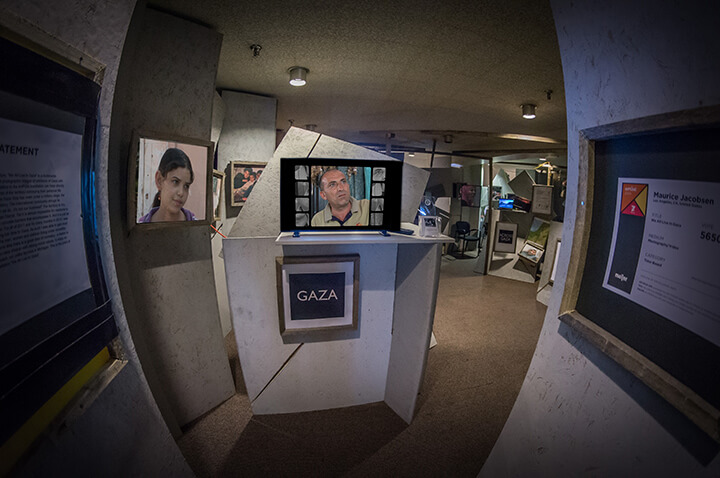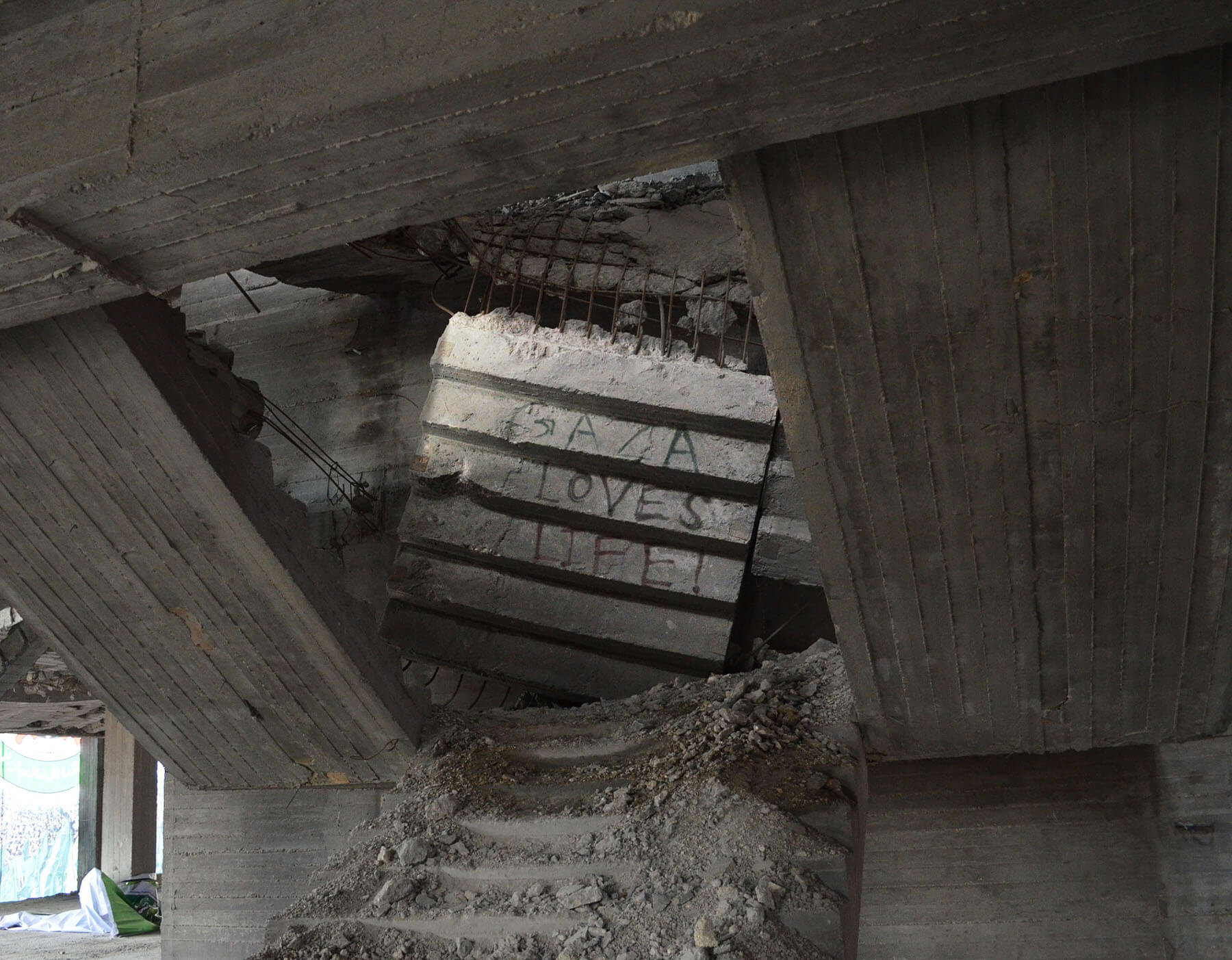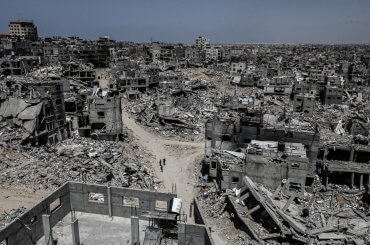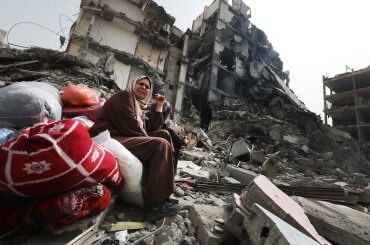Visitors to Maurice Jacobsen’s multimedia exhibit “WE ALL LIVE IN GAZA,” which was recently on display at the ArtPrize contest held annually for the past six years in Grand Rapids, Michigan have immediately found themselves in the presence of striking portraits of Palestinians of all ages and from all walks of life who hail from different parts of the blockaded Palestinian territory. Jacobsen, a Jewish-American independent filmmaker originally from the Grand Rapids area who’s now resident in Nazareth, Israel, lived for sixteen continuous months in Gaza in the aftermath of “Operation Cast Lead.” During his stay in the Strip, Jacobsen worked with a variety of Gazan organizations and individuals. Some of them–like painter and small gallery owner Basel el Maqousi–he came to know well and they become the subjects of a documentary on which his installation is based.
On the face of it, ArtPrize and Grand Rapids may seem like improbable settings in which everyday Americans can come face-to-face with the faces of people who have been continually besieged and repeatedly attacked by the armed forces of the United States’ principal ally in the Middle East. The contest is the brainchild of a bohemian scion of the Amway business empire, which originated and has its world headquarters in West Michigan, a part of the state long reputed for its deep-seated conservatism. Critics argue that ArtPrize serves as a veneer for the ethically dodgy economics that underpin the company’s pyramid-scheme structure and for the various unsavory right-wing political agendas that the corporation’s owners have funded. Artistic criticisms of the competition focus on the unchallenging nature of much of the art on display and on the way in which ArtPrize and its corporate underwriters promote and champion a competitive neoliberal spirit among its participants. (The winner of the contest obtains a $200,000 prize and there are several lesser prizes as well.)
Nevertheless, the fact remains that every day for three whole weeks the tens of thousands of visitors who throng the numerous indoor and outdoor venues sprinkled around three square miles in downtown Grand Rapids can see (for free) a considerable number of arresting and occasionally counter-hegemonic works of art amid the assorted schlock and whimsy. In the past two years few of these creations have been as well-thought out and as arrestingly if subtly critical of received political opinion in the US as Jacobsen’s successive multi-media exhibits on Palestine.
In 2013, Jacobsen mounted an installation called “Facing Al-Aqaba” in a sizable greensward nestled between the Gerald R. Ford Presidential Museum and the Grand River, which wends its way through the city’s downtown. Pedestrians crossing over a nearby bridge to see the many artworks installed inside and outside the museum would in many cases unwittingly find themselves walking down a spacious corridor flanked by life-size photographic banner portraits of the villagers of Al-Aqaba, an occupied hamlet in the West Bank in which Jacobsen lived for several months. Inside a rudimentary wooden structure situated at the foot of the passageway formed by the banner portraits, amongst which viewers could stroll and linger, visitors could watch video feed featuring the villagers’ testimonies of their lives under Israeli occupation. Often, they could also share their impressions with Jacobsen and with student volunteers from area colleges.
The humanizing power and visibility of Jacobsen’s Al-Aqaba exhibit led some local Zionists to pre-emptively protest the entry he submitted this year. Although those efforts proved fruitless, unlike last year in 2014 Jacobsen was unable to obtain a highly visible spot on one of the competition’s most frequently trodden circuits. Nevertheless, although this year’s installation has had less exposure than the Al-Aqaba project, according to the artist the visitor flow has fluctuated between a steady trickle and an occasional flash flood. During my own three longish visits at non-peak times, three or four people came through the exhibit every few minutes, and it’s possible that up to several thousand people may have seen it. On top of that, a couple of hundred of students and faculty at area colleges have viewed the documentary on which the installation is based. (The portraits of Palestinians that serve as the exhibit’s focus consist of frames culled from the video, retouched, and then printed on fine fabric.)
Located inside Fountain Street Church, a non-denominational liberal congregation downtown, “WE ALL LIVE IN GAZA” is intended to echo the bizarrely angled look of a bombed out apartment that Jacobsen walked around in shortly after the conclusion of “Operation Cast Lead,” a photograph of which appears on one of the many posters that publicize and accompany the exhibit. Large boards of wood positioned at a variety of odd angles and painted uniformly in a matt grey jarringly divide up a low ceilinged mezzanine area between a large foyer and a hall that is entirely taken up by the installation. Furthermore, two floor-to-ceiling wooden walls painted in the same dull color flank the whole space and serve to convey the vitality-sapping feeling of living under siege. (The Church declined to allow Jacobsen to play the sound of bomb explosions.)

Yet from the moment in which visitors mount up to the mezzanine they are confronted with the concrete human reality of Gaza in all its individualized diversity and complexity. Before entering the main space of the exhibit, viewers see successive faces fading in and out on a computer monitor mounted at the top of the steps leading up to the exhibit. After passing the monitor, the first thing that hits the eye is another stunning range of countenances artfully affixed onto the roughly painted wooden boards and walls that make up the bulk of the installation.
Here, taken from a variety of angles and set in rough-hewn wooden frames, are the faces of smiling brothers, of middle-aged men with furrowed brows, of an unshaven farmer inhaling the aroma of the bouquet of herbs he’s clutching, of a striking young woman wearing lipstick and a pink hijab framed by a jet black border, of a handsome young man playing an electric oud, of a sad looking little girl smiling wanly at the camera, of a teenager with the colors of the Palestinian flag painted across his radiant face. There is even a surprising profile of a be-capped bagpiper, a member of a troupe that Jacobsen stumbled upon while they were rehearsing for the celebratory welcome that Gazans were going to extend to the Mavi Marmara.

As the documentary that accompanies the exhibit makes clear, many of the subjects of these portraits have survived horrors. Some of them have had their homes bombed or their personal belongings incinerated. Some have seen their loved ones killed by bombs, bullets, or shells. And amid and between military assaults all have had to endure the manifold hardships and indignities of life under siege.
Despite these undeniable realities, however, and despite the physical discomfort that negotiating the exhibit’s angular wooden boards and narrow passageways entails, what the installation’s portraits, videos, documentaries, and musical clips chiefly convey is the quality of everyday resilience captured by the Arabic word sumud, steadfast, dignified resistance in the face of the sort of cold, calculating force that Israel pits against them with its formidable instruments of repression and death. In one of the three videos that play in a feedback loop amid the portraits, a noisy tank that lumbers menacingly around the Rafah crossing emblematizes that force and the machinery that it sets in motion. Yet despite the overweening ugliness of the war machine and of the ethno-nationalist ideology of which it is a material expression, the viewer’s focus is repeatedly drawn instead to the beauty and variety of the faces that gaze at us from Gaza.

The Argentinean novelist Julio Cortázar once referred to the resilience of his Jewish co-national Juan Gelman as an “unthinkable tenderness.” Gelman, who frequently spoke out against Israel’s depredations and spoke up for Palestinian rights, lost his son and daughter-in-law to military repression and was forced into a long exile. That same quality of barely comprehensible tenderheartedness is discernible not just in many of the visages of the Gazans whose lives Jacobsen has represented for an art-going public in a medium-sized Midwestern city, but also in the voice of Ayman Mghamis, a then 24 year-old recent English major and Gazan hip-hop artist. In a segment from the documentary that visitors can watch on a large screen just before exiting the installation, Mghamis first describes in a soft-spoken tone the death of his father in an Israeli attack. He also notes that before Cast Lead he had wanted to flee Gaza and never return, but that after the invasion he decided that his place was among his people, and that he wanted to devote himself to capturing their struggles and aspirations in song.

It is indicative of the dysfunction that Gazans are forced to live with that five years after the invasion that took Mghamis’s father’s life and those of hundreds of other people like those whom we see in the portraits, the Strip’s beleaguered inhabitants once again had to brace themselves for another spasm of Israeli bombing and shelling. Upon hearing the young rapper tell his story while standing inside his bombed family home we could be forgiven for thinking that he’s describing one of the many devastating tragedies that this past summer’s Israeli invasion was responsible for. But it is a measure of Gazans’ dignified resilience that as Mghamis huskily intones (in English) during a stage performance that’s captured on the video, “We don’t need neither food not drink, we want to make, we want to build, and also, we want…we want to be.”
Jacobsen’s work complements that of Palestinians like Laila El-Haddad. El-Haddad’s book on Gaza’s cuisine fleshes out the humanity and achievement of the people who created it and whom it sustains in ways that no straightforward political analysis or declarative statement can manage to do. In bringing the faces and voices of Gazans to the Midwest, Jacobsen has enlarged the space in which Americans can understand who the Palestinians are and what their struggles are all about. “WE ALL LIVE IN GAZA” can help viewers grasp right away that Palestinians are people, not stereotypes, and that while they are being victimized by an overweening ethno-nationalist state, they are not mere abject victims of force majeure but human beings with inalienable rights who are being unjustly occupied, blockaded, attacked, and prevented from flourishing. As one young man who passed through the exhibit twice in a row mentioned to me, “This is so moving, to see all these people…real people.”
In the middle of the photo that Jacobsen took of the bombed-out home that his installation seeks to echo, three defiantly affirmative words are inscribed on the steps of a dusty set of stairs that dangles precariously from a destroyed floor: “GAZA LOVES LIFE.” The variety of expressions, moods, and features on the faces that Jacobsen’s portraits capture explodes the kind of dehumanizing propaganda about Palestinians that was obligingly promoted by the likes of Elie Wiesel during the most recent Israeli assault on Gaza’s homes, schools, and hospitals. They make it abundantly clear that the forces of life and of justice are on the side of an oppressed and resilient people.

Note: Thanks to the overwhelmingly positive response that both installations have garnered, Jacobsen plans to combine both the Al-Aqaba and Gaza projects in one large installation. He also intends to return to Gaza in December to test a water filtration device developed by a West Michigan engineering firm and to try and arrange to bring to Grand Rapids for medical treatment Gazan children wounded in the most recent invasion. To learn more about these projects interested readers can contact Jacobsen directly at maurice.jacobsen@gmail.com.



what an incredible article. i am completely blown away. the art, the painted photos (or screenshots) are magnificent. i wish i could see this show. i wish it was going on the road. thanks you so so much David Alvarez for bringing this to our attention. and a huge thank you to the artist Maurice Jacobsen.